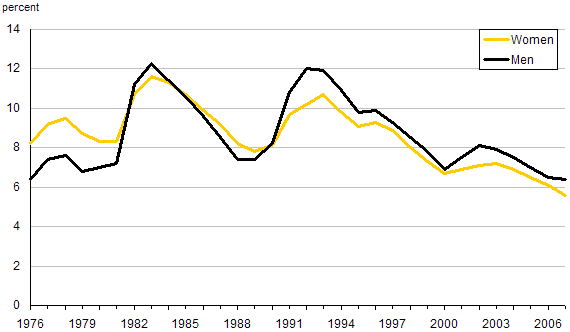Publications
The Canadian Labour Market at a Glance
Unemployment rates, by sex
Archived Content
Information identified as archived is provided for reference, research or recordkeeping purposes. It is not subject to the Government of Canada Web Standards and has not been altered or updated since it was archived. Please "contact us" to request a format other than those available.
Women have a lower unemployment rate than men
-
Since 1990, the unemployment rate for women has been consistently lower than that for men. On average in 2007, the unemployment rate for women was 5.6%, while the rate for men was 6.4%. In contrast, from the mid 1970s to the late 1980s, the unemployment rate for men was usually below that for women. The only exception to this trend was in the early 1980s, when the recession affected considerably more men than women.
-
The explanation for the lower unemployment rate for women lies in part in the growth of service industries in Canada, where the unemployment rate is lower than in the goods-producing sector. In 2007, 88.4% of employed women worked in service industries, such as health care and social assistance, and retail trade, compared with 65.5% of employed men. As well, greater proportions of women had work experience and higher levels of education, resulting in longer periods of work.
-
While participation in the labour market among women has increased over the past three decades, the rate for men has decreased slightly throughout much of the same period. In 2007, the participation rate among women was 62.7%, 17.0 percentage points higher than in 1976. In contrast, the participation rate among men in 2007 (72.7%) remained below the peak reached in 1981 (78.4%).
Chart B.3
Unemployment rates, by sex, 1976 to 2007

Source: Statistics Canada, Labour Force Survey, CANSIM table 282-0002.
- Date modified:
